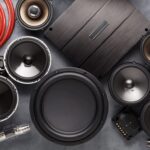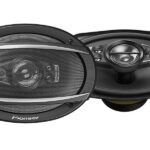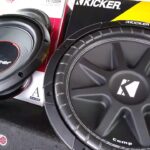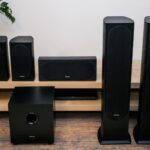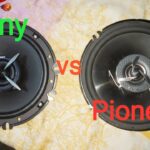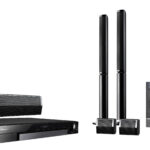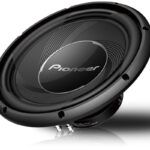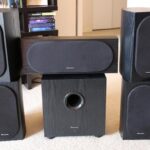A component speaker in car audio is a system that separates the different audio frequencies, allowing for clearer and more balanced sound reproduction. It consists of a separate tweeter, mid-range driver, and crossover network.
When upgrading your car audio system, one component that you should consider is the component speaker. This system is designed to enhance the sound quality of your car audio by separating the different frequencies and reproducing them more accurately. Unlike coaxial speakers, which have the tweeter and mid-range driver combined into a single unit, component speakers have a separate tweeter, mid-range driver, and crossover network.
This separation allows for better imaging, increased power handling, and improved clarity. We will dive deeper into what exactly a component speaker is and how it can transform your car audio experience.
Components Of A Car Audio System
Component speakers are a crucial part of a car audio system. These speakers are designed to deliver high-quality sound and provide a more immersive listening experience. Rather than having a single speaker that handles all the audio frequencies, component speakers consist of multiple drivers, such as tweeters, woofers, and crossovers, each responsible for a specific frequency range.
Tweeters are responsible for reproducing high frequencies, resulting in clear and detailed sound reproduction. Woofers, on the other hand, handle the low frequencies, producing deep and powerful bass. Crossovers ensure that each driver receives the appropriate frequency range, preventing distortion and optimizing sound quality.
When selecting component speakers, it is important to consider factors such as power handling, sensitivity, and frequency response to ensure compatibility with your car audio system. Investing in high-quality component speakers can greatly enhance your overall listening experience, allowing you to enjoy your favorite music in a whole new way. So, if you’re looking to upgrade your car audio system, consider incorporating component speakers for improved audio performance.
What Is A Component Speaker
A component speaker is a type of speaker system commonly used in car audio setups. It is designed to provide high-quality sound reproduction by separating different audio frequencies and directing them to specific drivers.
Component speakers consist of several components, including a woofer, tweeter, and crossover. The woofer handles low-frequency sounds such as bass, while the tweeter is responsible for high-frequency sounds like vocals and instruments. The crossover filters and distributes the audio signals to the appropriate drivers, ensuring clear and accurate sound reproduction.
What sets component speakers apart from regular speakers is their ability to deliver better sound quality and more precise imaging. By separating the audio frequencies and directing them to specialized drivers, component speakers minimize distortion and enhance the overall audio experience.
If you’re looking to upgrade your car’s audio system and enjoy crisp, detailed sound, component speakers are definitely worth considering. With their superior sound reproduction capabilities, they can significantly enhance your listening pleasure on the road.
Advantages Of Component Speakers
What is a Component Speaker in Car Audio
Component speakers offer several advantages that greatly enhance the overall audio experience in car audio systems.
- Enhanced sound quality: Component speakers are designed to provide superior sound reproduction compared to regular coaxial speakers. With separate tweeters and woofers, they offer clearer highs and more defined lows, resulting in a more immersive audio experience.
- Higher power handling: Component speakers are built to handle more power, allowing for louder and more dynamic audio playback without distortion. This makes them ideal for car audio enthusiasts looking for a powerful and impactful sound system.
- More accurate sound imaging: With separate tweeters that can be mounted higher in the car, component speakers offer improved sound imaging. This means that the audio will have a more precise positioning, creating a realistic soundstage where each instrument and vocal can be heard distinctly.
- Improved frequency response: Component speakers are designed to cover a wider frequency range, resulting in a more balanced and detailed sound reproduction. This means that you can enjoy crisp highs, rich midrange, and powerful bass without any frequency loss or distortion.
Anatomy Of A Component Speaker
A component speaker is an essential part of car audio systems. It is designed to reproduce sound accurately and provide a high-quality listening experience in vehicles. The anatomy of a component speaker consists of three main components: the woofer, the tweeter, and the crossover.
The woofer is responsible for producing low-frequency sounds, such as bass and drums. It is a larger speaker that typically handles frequencies up to 500 Hz. The tweeter, on the other hand, reproduces high-frequency sounds like cymbals and vocals. It is smaller in size and can handle frequencies from around 2,000 Hz and higher.
To ensure a seamless transition between the woofer and tweeter, a crossover is used. The crossover directs the appropriate frequencies to each component, preventing distortion and ensuring that each speaker operates within its optimal range. It acts as a filter, allowing only the desired frequencies to reach the woofer and tweeter.
A component speaker system offers superior sound quality compared to standard coaxial speakers. It allows for greater customization and enables listeners to experience the full range of sound in their car audio system.
Woofer
The woofer is a crucial component in a car audio system as it handles the lower frequency range, providing deep, rich bass. Its primary role is to reproduce low-frequency sounds accurately and with clarity. A **woofer** consists of a cone, voice coil, magnet, and suspension system. The cone moves back and forth, generating sound waves that produce the bass notes.
High-quality **materials** are used in the construction of woofers to ensure optimal performance. Sturdy and lightweight materials like polypropylene, woven fabrics, or synthetic fibers are commonly used for the cone. The voice coil, usually made of copper wire, enables the movement of the cone when an electrical signal passes through it. The magnet helps control the movement of the voice coil, enhancing the stability and precision of the sound produced. The suspension system, including the surround and spider, allows the cone to move freely while maintaining proper alignment.
| Woofer Sizes | Impact on Sound Quality |
|---|---|
| 6.5 inch (16.5 cm) | The most common size, provides a good balance between bass response and overall sound quality. |
| 5.25 inch (13.3 cm) | Smaller size results in less bass output but may be suitable for certain car models with limited space for speaker installation. |
| 6×9 inch (15×23 cm) | Larger size delivers deeper bass and higher volume levels, ideal for those who prioritize powerful, low-frequency performance. |
Tweeter
Component speakers are an essential part of car audio systems, and one of the key components is the tweeter. The tweeter plays a crucial role in reproducing high-frequency sounds and capturing those delicate details that make the music come alive.
There are various types of tweeters available, including soft dome, hard dome, ribbon, and cone. Each type has its own unique characteristics and sound reproduction abilities, allowing you to customize your audio experience.
The placement and positioning of tweeters also play a vital role in optimizing sound quality. Mounting them at ear level ensures that the high-frequency sounds reach your ears directly, resulting in a more immersive and accurate soundstage.
In conclusion, tweeters are an integral part of component speakers in car audio systems. Understanding the role, types, and proper placement of tweeters can greatly enhance your listening experience.
Crossover
A component speaker is an essential part of car audio systems. One key component of a component speaker is the crossover. The purpose and function of a crossover is to split the audio signals into different frequency ranges for different speaker drivers. This ensures that each driver handles the frequencies it is best suited for, resulting in improved sound quality and clarity.
There are different types of crossovers available in car audio systems, such as passive crossovers and active crossovers. Passive crossovers are often included with component speakers and are installed between the amplifier and the speaker drivers. Active crossovers, on the other hand, require external power and are generally more flexible in terms of adjusting crossover frequencies and slopes. They are typically used in more advanced audio setups.
Another important feature of some crossovers is their bi-amp and tri-amp capabilities. These crossovers allow for the separate amplification of different frequency ranges, enabling even greater control and customization of the sound output.
Installation And Placement Of Component Speakers
A component speaker in car audio is a system that includes separate tweeters, woofers, and crossovers, designed to deliver high-quality sound and a more immersive listening experience compared to coaxial speakers. Installation and proper placement are key factors in achieving optimal sound quality.
When installing component speakers, certain tools and equipment are necessary. These include wire cutters, crimpers, a multimeter, and speaker connectors. Ensure that you have these tools on hand before beginning the installation process.
Proper placement of component speakers is crucial for the best sound performance. Tweeters should be positioned at ear level, facing the listener, to achieve accurate high-frequency sound reproduction. Woofers are typically installed in the lower door panel or kick panel to enhance mid-bass tones.
If you prefer a DIY installation, here are a few tips to keep in mind. Begin by carefully reading the installation instructions provided by the manufacturer. It’s essential to follow the recommended wiring diagrams and securely fasten all connections. Take your time and double-check your work to avoid any potential issues or sound quality compromises.
Matching Component Speakers With Amplifiers
|
Matching Component Speakers with Amplifiers When it comes to selecting the right amplifier for your component speakers in a car audio system, there are a few important factors to consider – power requirements and impedance matching. Power requirements: Component speakers have specific power handling capabilities, usually measured in watts RMS. It is crucial to match the power output of the amplifier with the power handling capabilities of the component speakers to ensure optimal performance and prevent any potential damage. Impedance matching: Impedance refers to the electrical resistance that an amplifier needs to drive the component speakers effectively. It is essential to select an amplifier that matches the impedance rating of the component speakers to ensure a proper power transfer and avoid any distortion. Choosing the right amplifier for component speakers can significantly enhance the overall sound quality and performance of your car audio system. Take into consideration the power requirements and impedance matching to achieve the best results. |
Tips For Selecting Component Speakers
A component speaker in car audio refers to a system that separates the tweeter and woofer, allowing for better sound quality and accuracy. When selecting component speakers for your car, there are several factors to consider.
Budget considerations play a crucial role in determining the type and quality of component speakers you can afford. It’s essential to find a balance between cost and performance to ensure you get the best value for your money.
Speaker sensitivity is another important aspect to consider. Higher sensitivity speakers require less power to produce the same sound level, making them ideal for low-powered car audio systems.
Speaker size and fitment are also critical factors. It’s important to choose component speakers that fit properly in your car’s speaker locations, ensuring an optimal fit and sound quality.
Remember, selecting the right component speakers for your car audio system can greatly enhance your listening experience. Consider your budget, speaker sensitivity, and fitment to make an informed decision that suits your needs and preferences.
Common Issues With Component Speakers
Component speakers are a popular choice for car audio enthusiasts due to their superior sound quality and customizable setup. However, like any audio equipment, they can also face certain issues that can affect their performance. One common problem is distortion, where the sound becomes muffled or unclear. This can be caused by various factors, such as improper installation or incorrect wiring. Additionally, component speakers are susceptible to speaker damage, particularly if they are not handled with care or exposed to excessive power. It’s important to ensure that the speakers are properly secured and protected. Another issue can arise from wiring and connectivity problems, which can result in intermittent audio or complete loss of sound. Regularly inspecting the wiring connections and ensuring they are secure can help mitigate these issues.
Maintaining And Caring For Component Speakers
Maintaining and Caring for Component Speakers
Cleaning and dusting: Regularly cleaning and dusting your component speakers is essential to ensure optimal audio performance. Use a soft, lint-free cloth to gently wipe away any accumulated dust or dirt from the speaker cones and grilles. Avoid using harsh chemicals or abrasive materials that can damage the speakers.
Checking for loose connections: Periodically inspect the speaker connections for any loose or frayed wires. Ensure that the connections are secure and tightly fitted to prevent audio distortion or loss. If you find any loose connections, carefully reattach them or consider seeking professional assistance.
Troubleshooting common issues: In case of any audio issues, such as distortion or uneven sound, troubleshoot the component speakers before seeking repairs. Make sure the speaker wires are properly connected, adjust the audio balance, and check the equalizer settings. It’s also advisable to refer to the user manual or reach out to the manufacturer for specific troubleshooting guidelines.
Conclusion
To sum it up, a component speaker is a crucial element in achieving high-quality sound reproduction in car audio systems. By separating the different frequency ranges and distributing them to dedicated drivers, these speakers offer a more realistic and immersive listening experience.
With better clarity, detail, and depth, component speakers are the preferred choice for audiophiles looking to enhance their in-car music experience. So if you’re seeking unparalleled sound quality on the road, consider upgrading to a component speaker system.
Frequently Asked Questions Of What Is A Component Speaker In Car Audio
What Is A Component Speaker In Car Audio?
A component speaker in car audio is a high-quality speaker system that consists of separate components, including a tweeter, woofer, and crossover. These speakers provide superior sound clarity and accuracy, allowing you to hear every detail of your music. They are perfect for audiophiles who crave the best sound experience in their car.
Why Should I Upgrade To A Component Speaker System?
Upgrading to a component speaker system in your car audio setup can significantly enhance your listening experience. Unlike coaxial speakers, component speakers offer separate drivers for different frequencies, resulting in better sound imaging and accurate reproduction of music. The improved clarity, detail, and depth of the audio will make your drives more enjoyable.
How Do Component Speakers Differ From Coaxial Speakers?
Component speakers differ from coaxial speakers in terms of design and performance. Coaxial speakers are integrated systems with a single driver that handles all frequencies, while component speakers have separate tweeters, woofers, and crossovers to handle different frequency ranges. This design allows component speakers to deliver better sound quality, imaging, and overall performance compared to coaxial speakers.
Can I Install Component Speakers In Any Car?
Yes, you can install component speakers in almost any car. However, the installation process may vary depending on your car’s make and model. It is recommended to consult a professional car audio installer to ensure proper installation and compatibility with your car’s electrical system.
They can also provide guidance on the best placement for the speakers to achieve optimal sound quality.
